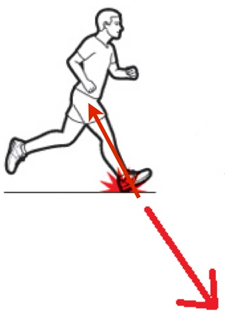What Is Overstriding
Open any running magazine, and you'll find something about the evil of overstriding and how to correct it. But what is overstriding? Is it bad, and if so, why?
The problem is that there is a lot of misinformation out there about the what’s, why’s, and how’s of overstriding. Let's look at this increasingly common term and how it applies to us as runners.
Overstriding first gained traction among the running public a few years ago. It coincided with the introduction of minimalism and lower heel-to-toe drops as part of our running lexicon. Correcting overstriding was one of the primary promised improvements.
First off, not everyone does (nor should they) run the same. We come in different sizes and strengths, so to claim a universally perfect stride for everyone is ridiculous. That being said, as we go through our gait cycle, we want to be as efficient as possible. The most common inefficiency we see is overstriding.
Overstriding is when your foot lands in front of your center of mass or gravity.  When your foot lands too far out front, there is a braking action. Creating a braking action with every step is like trying to drive with your parking brake on. It's not very efficient and something's likely to break.
When your foot lands too far out front, there is a braking action. Creating a braking action with every step is like trying to drive with your parking brake on. It's not very efficient and something's likely to break.
So how to do we try to correct braking and breaking? Initially, people attacked the dreaded heel strike. If you don’t heel strike, you won’t overstride! However, the problem with trying to "fix" heel striking is that heel striking, in and of itself, is not bad. Simply changing what part of your body hits the ground first is far too simplistic. That's like trying to change the result of a math problem without changing the problem. For instance, if you want 5, you can't change 2+2=4 to 2+2=5, just so you can have the value you want. What we need to do is fix the equation so we don't end up with a gait cycle that results in overstriding.
Heel striking was given a bad rap because people assumed elites don’t heel strike. In reality, elites are fairly evenly spread between heel, midfoot and forefoot strikers. What they do very well—and this is what we should aim for—is land with a neutral shin angle.
You want your shin to be as perpendicular to the ground as possible when your foot initially contacts the ground. How you get there is the key—and brings us back to overstriding.
The most common reason for overstriding is that our glutes don't like to work as quickly and efficiently as we need them to. Their job is to cause our legs to swing back underneath us. Elite runners have (and develop) glutes that work much better than ours do. That is why elites tend to run over the ground rather than constantly falling back down to the ground.
Improving glute function is the primary step to alleviate overstriding. By getting our glutes to fire better, we'll naturally allow our bodies to transition into a more efficient stride. Glute dysfunction in runners can be due to weakness and/or inhibition. Correcting overstriding is a constant maintenance process, but it is a deficiency that can be overcome.
The Fleet Feet Hip Mobility and Functional Strength classes focus on strengthening your glutes as a movement pattern rather than simply working a muscle. Speed School is designed to help develop the neuromuscular firing pattern for your glutes. Let us help you beat overstriding!
Good Luck and Happy Racing!
Coach Cary
 Tim Cary is FLEET FEET's Assistant Training Manager, coach of the FLEET FEET-sponsored Runnababez Elite team, and manager of the FLEET FEET Racing Team. Over his 20 years of coaching, Tim has coached athletes to three national team championships, five national individual championships, two national records, and numerous All-American and All-State honors. Click here to receive Tim's weekly article via email.
Tim Cary is FLEET FEET's Assistant Training Manager, coach of the FLEET FEET-sponsored Runnababez Elite team, and manager of the FLEET FEET Racing Team. Over his 20 years of coaching, Tim has coached athletes to three national team championships, five national individual championships, two national records, and numerous All-American and All-State honors. Click here to receive Tim's weekly article via email.
Connect With Us
see the latest from Fleet Feet St. Louis